Resilience Tips for Caregivers: How to Stay Strong While Caring for Others
Introduction
Caring for someone you love — whether it’s a parent, partner, child, or patient — is one of the most profound acts of compassion. Yet it can also be one of the most draining.
Between medical appointments, emotional support, and constant vigilance, caregivers often forget the one person who also needs care: themselves.
Caregiver burnout is real. It’s not a sign of weakness or lack of love — it’s a sign of human limits. Building resilience as a caregiver means learning how to protect your own well-being, refill your emotional tank, and stay grounded amid constant demands.
This guide explores the emotional, physical, and neurological realities of caregiving — and offers science-backed strategies to help you restore balance, peace, and self-compassion. 🌸
Looking for supplements for Resilience? Click here.
💞 The Emotional Reality of Caregiving

Caregiving is both a gift and a test of endurance. It calls for patience, empathy, and strength — but it also exposes you to continuous stress.
🌧️ The Paradox of Compassion
You give your heart fully, but your emotional reserves are finite.
You want to help, but you can’t fix everything.
You love deeply, but you grieve daily — the person they were, or the freedom you once had.
Many caregivers experience a quiet form of grief known as “ambiguous loss” — mourning gradual decline, change, or uncertainty rather than death itself.
🪷 Resilience begins when you stop trying to be invincible and start allowing yourself to be human.
Looking for online therapy ? Click Here.
🔥 The Physiology of Caregiver Stress
The body doesn’t distinguish between emotional and physical stress. When caregiving feels constant, the stress response — governed by the HPA axis (hypothalamic-pituitary-adrenal system) — stays “on,” flooding your body with cortisol and adrenaline.
Over time, this leads to:
Fatigue and sleep problems 😴
Brain fog and forgetfulness 🧠
Irritability or emotional numbness 💬
Weakened immunity 🤒
Depression or anxiety 🌧️
This isn’t a failure of character — it’s biology. You’re not meant to live in emergency mode forever.
🌿 Resilience means learning to return the body to calm, again and again.
🌼 Step 1: Acknowledge Your Emotional Load
Caregivers often minimize their stress:
“Others have it worse.”
“I should be stronger.”
But denial blocks recovery.
The first step toward resilience is recognition.
Try naming your feelings — not as judgment, but as data:
“I feel exhausted.”
“I feel guilty.”
“I feel lonely.”
🧘 Why it matters: Naming emotions reduces amygdala activity (the brain’s alarm system) and activates the prefrontal cortex — restoring calm and perspective.
💬 Acknowledgment is the beginning of healing.
🌿 Step 2: Redefine Strength
In caregiving culture, “strength” often means self-sacrifice. But resilience isn’t about carrying everything — it’s about knowing what to carry and when to rest.
Ask yourself:
What can I realistically do today?
What can I delegate or delay?
What can I let go of with compassion?
🪷 True strength is flexible. It bends under pressure but doesn’t break.
🌤️ Step 3: Create Micro-Moments of Restoration
You may not have hours for self-care, but you have moments — and moments matter.
🌸 Mini Restorative Practices
60 seconds of slow breathing (inhale 4s, exhale 6s)
A cup of tea without multitasking
A short walk outdoors
Listening to one favorite song
Gratitude journaling (3 lines)
Research shows that even two minutes of conscious relaxation lowers cortisol and improves heart-rate variability (a measure of nervous system balance).
💚 Tiny breaks are not luxuries — they’re refueling stops.
💬 Step 4: Release Guilt
Caregivers often battle guilt — for being tired, needing space, or feeling resentment.
But guilt doesn’t serve the person you care for; it drains your energy to care at all.
Try this reframe:
Instead of: “I shouldn’t feel this way.”
→ Say: “It’s okay to have feelings. I’m doing my best.”
Instead of: “I need to be available 24/7.”
→ Say: “Rest helps me show up better.”
🪷 Self-care is not selfish — it’s sustainable compassion.
Looking for online therapy ? Click Here.
🌱 Step 5: Regulate Your Nervous System
Because caregiving keeps the body on alert, learning to self-regulate is essential.
💨 Grounding Tools for Daily Use
Breathwork:
Inhale for 4 seconds, exhale for 6 seconds — repeat for 2 minutes.
(This activates the vagus nerve, lowering stress.)
Progressive relaxation:
Tense and release muscle groups from head to toe.
Cold water splash:
Stimulates the vagus nerve and resets the body’s stress response.
Gentle movement:
Stretch, walk, or do yoga to discharge stress hormones.
🌿 A calm body leads to a calm mind.
Want to try Breathwork? Click Here.
🌻 Step 6: Build a Care Team
You can’t pour from an empty cup, and you can’t sustain caregiving alone.
Ask for — and accept — help.
👥 Support Options
Family or friends (even for small tasks like groceries)
Respite care or volunteer support groups
Online caregiver communities
Professional counselors or spiritual advisors
Many people want to help but don’t know how — tell them exactly what you need.
Even one afternoon off can renew your resilience.
💞 Asking for help isn’t a burden — it’s an invitation for connection.
🌸 Step 7: Manage Compassion Fatigue
Compassion fatigue occurs when your empathy exceeds your emotional capacity. You may start feeling detached, numb, or irritable — not because you don’t care, but because your system is overloaded.
💚 How to Cope
Set emotional boundaries: You can care for someone without carrying their pain.
Practice emotional hygiene: After intense days, journal or meditate to release stress.
Focus on what’s within control — not every outcome is yours to manage.
🪷 Empathy is sacred — protect it from exhaustion.
🌼 Step 8: Nourish Your Body
Your physical state directly influences your emotional endurance.
🍎 Nutrition Tips for Caregivers
Protein at every meal (to stabilize blood sugar and energy)
Hydrate consistently (dehydration mimics fatigue)
Omega-3 fats (reduce inflammation and support mood)
Magnesium-rich foods (spinach, almonds, dark chocolate)
Avoid skipping meals or relying solely on caffeine — both raise cortisol.
💊 Optional supplements (with doctor’s advice):
Magnesium glycinate 🪷 relaxation
B-complex 🌞 energy
Vitamin D3 ☀️ mood support
Rhodiola or ashwagandha 🌿 stress regulation
💚 Food isn’t fuel — it’s resilience in edible form.
🌻 Step 9: Protect Sleep Like Medicine
Chronic sleep deprivation amplifies stress and reduces emotional regulation. Yet many caregivers feel guilty for sleeping.
You deserve rest. You need rest.
💤 Sleep Strategies
Create a consistent bedtime (even 6 hours of quality sleep helps).
Avoid screens and caffeine 2 hours before bed.
Use calming rituals — chamomile tea, magnesium, or soft music.
If interrupted at night, take micro-naps (20 minutes) during the day.
🪷 Sleep is not wasted time — it’s emotional repair.
🌿 Step 10: Redefine Success
Caregivers often measure worth by outcomes:
“Did I do enough?”
“Am I making a difference?”
But resilience comes from shifting success from results to presence.
Success is:
Showing up, even tired.
Being kind under pressure.
Adapting when plans change.
🌼 Perfection burns out; presence sustains.
🌻 Step 11: Practice Mindful Acceptance
Not every situation can be fixed — but every moment can be met with awareness.
Mindfulness helps you stay grounded in “what is,” instead of spiraling in “what if.”
🌸 Daily Practice:
Pause for 1 minute.
Notice your breath.
Feel your feet on the floor.
Whisper: “In this moment, I am enough.”
This calms the amygdala and restores emotional balance.
💚 Acceptance doesn’t mean approval — it means peace with reality.
🌿 Step 12: Release Emotional Residue
Caregiving builds up unspoken emotion — worry, grief, anger, exhaustion.
You need outlets to release it before it turns into burnout.
🧘 Emotional Detox Practices
Journaling 🖊️ — express, don’t edit.
Movement 🏃 — exercise clears emotional tension.
Creative outlets 🎨 — paint, sing, or garden.
Crying 😢 — it’s a natural stress release; tears literally remove cortisol.
🪶 Release isn’t weakness — it’s maintenance.
🌼 Step 13: Foster Joy Amid Duty

Joy is not disrespectful to struggle — it’s medicine for it.
Even 5 minutes of genuine laughter or sunlight recharges dopamine and serotonin, helping you feel alive again.
☀️ Micro-Joy Rituals
Watch a comedy clip
Spend time with a pet
Step outside at sunrise
Listen to uplifting music
💬 Joy is how the soul remembers it’s still alive.
🌸 Step 14: Stay Connected to Meaning
Caregiving can feel endless unless connected to purpose.
Ask:
Why am I doing this?
What values drive my care?
What does love look like in this chapter?
Reconnecting to meaning fuels intrinsic motivation — a deeper form of resilience that outlasts fatigue.
🌿 Purpose doesn’t remove pain, but it makes it bearable.
🌿 Step 15: Build a Personal Sanctuary
Create small spaces — physical or emotional — that feel like peace.
Your sanctuary could be:
A corner with candles and a blanket
A playlist of songs that soothe your heart
A short walk where no one calls your name
🪷 Your peace is sacred space. Protect it daily.
🌼 Step 16: Practice Self-Compassion
Caregivers often show compassion to everyone but themselves.
When you feel like you’re “not doing enough,” place a hand over your heart and say:
“I’m trying, and that’s enough.”
According to Dr. Kristin Neff’s research, self-compassion lowers stress hormones and boosts resilience — more than self-esteem or motivation alone.
💚 Speak to yourself the way you’d speak to someone you care for.
🌿 Step 17: Recognize Compassion Fatigue Early
Warning signs include:
Feeling detached or cynical
Avoiding emotional connection
Difficulty feeling empathy
Physical exhaustion
When you notice these signs, don’t push harder — pause sooner.
Even 24 hours of rest or emotional distance can restore empathy.
🌸 You can’t heal others while running on empty.
🌼 Step 18: Boundaries Are Acts of Love
Setting boundaries protects both you and the person you care for.
It keeps resentment from building.
It models healthy communication.
It ensures care remains sustainable.
💬 Example Phrases
“I need 10 minutes before we continue.”
“I want to help, but I also need to rest.”
“Let’s find a solution that supports both of us.”
🪷 Boundaries are not barriers — they’re bridges built with clarity.
🌻 Step 19: Accept Help — It Honors Everyone
Allowing others to assist doesn’t mean you’ve failed — it means you’re allowing community to function as it should.
Let people deliver meals, run errands, or simply listen.
Human beings evolved for co-regulation, not isolation.
💞 Let others be part of your resilience ecosystem.
🌸 Step 20: Practice Forgiveness
Caregiving brings frustration — with yourself, others, or even the person you’re caring for.
Forgiveness releases emotional tension trapped in the body.
Try:
“I forgive myself for being human.”
“I forgive others for not understanding.”
“I release what I can’t control.”
🧘 Forgiveness is the emotional reset button.
🌿 Step 21: Use Breath as a Reset Button
Your breath is always with you — use it as a moment-to-moment recovery tool.
Try the Box Breathing Technique (used by Navy SEALs):
Inhale 4s → Hold 4s → Exhale 4s → Hold 4s.
Repeat for 2 minutes. It lowers blood pressure and heart rate, activating calm.
🌬️ Every deep breath is a micro act of resilience.
🌼 Step 22: Honor Small Wins
Celebrate even small progress — a peaceful morning, a shared laugh, or a day without overwhelm.
The brain’s reward system (dopamine) thrives on acknowledgment.
💚 Small wins build big strength.
🌸 Step 23: Reflect on Your Journey
Journaling once a week about what you’ve learned or handled can build perspective.
Prompts:
“This week, I handled…”
“One thing I’m proud of…”
“One thing I’ll do differently…”
Reflection transforms chaos into coherence — a key pillar of emotional regulation.
🌻 Step 24: Find Support Circles
Support groups for caregivers provide emotional relief and practical wisdom.
Hearing “me too” reduces isolation and restores belonging.
Look for:
Online caregiver forums
Hospital or nonprofit support programs
Community or faith-based groups
🪷 Connection transforms exhaustion into solidarity.
🌿 Step 25: Remember — You Matter Too
Your health, your rest, your laughter — they’re not extras; they’re essential.
Caring for yourself isn’t stealing time; it’s extending your capacity to love.
“You can’t stop the waves, but you can learn to surf.” — Jon Kabat-Zinn 🌊
🧘 Resilience isn’t about perfection — it’s about presence.
💫 Final Thoughts: The Caregiver’s Path to Wholeness
Being a caregiver is one of humanity’s purest acts — a living expression of love. But love must include you, too.
Resilience means honoring your limits, protecting your peace, and remembering that your worth isn’t measured by endurance but by compassion — toward others and yourself.
💚 You are doing enough. You are enough.
📚 References
Figley, C. R. (1995). Compassion Fatigue: Coping with Secondary Traumatic Stress Disorder in Those Who Treat the Traumatized.
Neff, K. (2011). Self-Compassion. HarperCollins.
Kabat-Zinn, J. (2013). Full Catastrophe Living. Random House.
McEwen, B. S. (2007). Physiology and neurobiology of stress and adaptation. Physiological Reviews.
Siegel, D. J. (2010). The Mindful Brain. W.W. Norton & Company.
Walsh, R. (2011). Lifestyle and mental well-being. American Psychologist.
Lazarus, R. S. (1991). Emotion and Adaptation. Oxford University Press.
Van der Kolk, B. (2014). The Body Keeps the Score. Penguin Books.
Seligman, M. E. P. (2011). Flourish. Free Press.
Figley, C. R., & Bride, B. (2007). Compassion fatigue and resilience in caregivers.
Related Posts
-

Nootropics That Promote Calm and Rest
Explore the world of calming nootropics — natural brain enhancers that promote relaxation, better focus, and deeper rest. Learn how L-Theanine, magnesium, ashwagandha, and other adaptogens help balance your nervous system, reduce stress, and support restorative sleep.
-

Best Natural Supplement Stack for Sleep
Discover the best natural supplement stack for deep, restorative sleep. Learn how nutrients like magnesium, L-theanine, glycine, and calming herbs such as chamomile and ashwagandha work together to relax your body, calm your mind, and improve sleep quality—naturally and safely.
-

Combining L-Theanine and Magnesium for Sleep: A Calm Night, Naturally
Discover how combining L-Theanine and Magnesium can help you drift into deep, restorative sleep. Learn how this natural duo calms the mind, relaxes the body, and supports your nervous system—without grogginess the next morning.
-

How to Sleep Better After Intense Workouts
Struggling to fall asleep after a tough workout? Learn how to optimize your post-training recovery with nutrition, hydration, and science-backed sleep strategies. Discover how to calm your nervous system, balance hormones, and wake up fully recharged for your next session.
-

Ashwagandha and Valerian: A Bedtime Combo for Deep Rest and Emotional Reset
Discover the calming synergy of Ashwagandha and Valerian root, two natural sleep aids that help quiet the mind, ease anxiety, and promote deeper rest. Learn how this herbal duo supports the nervous system, balances stress hormones, and restores emotional peace — without next-day grogginess.
-

How to Create a Resilience-Boosting Diet
Discover how to build emotional and physical strength from the inside out with a resilience-boosting diet 🍎. Learn which foods stabilize your mood, how supplements like magnesium and omega-3s strengthen your stress response, and why pairing nutrition with breathwork and therapy creates lasting calm, focus, and vitality 🌿💪.
-

Best Teas and Herbal Blends for Calmness: Nature’s Way to Restore Inner Peace
Ashwagandha, the ancient adaptogenic herb, helps your body find balance during stress. Known as “Indian ginseng,” it supports cortisol regulation, boosts energy, and restores calm clarity. Discover how this powerful root promotes resilience, emotional balance, and steady vitality — one cup at a time. 🌸
-

Parenting and Emotional Strength: How to Raise Children Without Losing Yourself
Empathy is the bridge that connects hearts — the quiet power to understand, feel, and support another’s emotions without judgment. Learn how empathy strengthens relationships, enhances communication, and cultivates deeper compassion in everyday life. 🌿
-
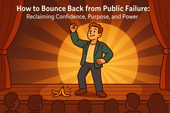
How to Bounce Back from Public Failure: Reclaiming Confidence, Purpose, and Power
Visualization is more than imagination — it’s brain training for resilience. By picturing calm, success, or healing, you activate the same neural pathways as real experience. Learn how daily visualization rewires your brain for confidence, emotional balance, and recovery from stress. ✨
-

Coping with Financial Stress Through Resilience: How to Stay Grounded When Money Feels Tight
Body awareness is the foundation of emotional resilience. By tuning into your body’s signals — tension, fatigue, or calm — you learn to recognize stress before it overwhelms you. Discover how mindfulness, gentle movement, and breathwork can deepen your connection with your body and restore balance from the inside out. 🧘
-

How to Stay Positive During Chronic Illness: A Guide to Emotional Strength and Hope
Creativity is more than art — it’s a form of healing. Whether through painting, writing, music, or small acts of expression, creativity helps release emotion, calm the nervous system, and reconnect you to joy. Discover how to use creativity as a tool for emotional balance, resilience, and self-discovery. 🌿
-

Building Resilience After a Breakup: How to Heal, Rebuild, and Rise Stronger
Social connection is one of the strongest predictors of emotional resilience. During difficult times, genuine relationships act as anchors — calming the nervous system, reducing stress hormones, and helping you regain perspective. Learn how cultivating real human connection can strengthen your mind, heart, and overall well-being. 🌿
-

How to Stay Emotionally Strong During Job Loss
Your emotions are powered by brain chemistry — a delicate balance of neurotransmitters like serotonin, dopamine, and cortisol. When these chemicals work in harmony, you feel calm, focused, and resilient. Learn how daily habits, nutrition, and mindfulness can support your brain chemistry and boost emotional well-being naturally. 🌿
-

The Role of Hormones in Emotional Stability: How Your Chemistry Shapes Your Calm
Hormones shape more than your body — they shape your emotions, resilience, and sense of calm. From cortisol to serotonin, these chemical messengers influence how you react to stress, connect with others, and recover from challenges. Learn how to balance your hormones naturally to build lasting emotional stability and harmony within. 💫
-

Mitochondria and Emotional Energy: The Cellular Power Behind Your Mood
Breathwork is one of the most powerful tools for emotional regulation and cellular balance. Through intentional breathing, you can calm your nervous system, increase oxygen flow to the brain, and even support mitochondrial energy. Learn how conscious breathing connects body and mind — transforming stress into presence and emotional strength. 🌿
-

Inflammation and Its Impact on Mood Resilience: The Silent Link Between Body and Mind
Inflammation doesn’t just affect the body — it impacts the mind. Chronic inflammation alters brain chemistry, depletes serotonin, and makes emotional recovery harder. Learn how calming inflammation through nutrition, mindfulness, and sleep can restore balance, resilience, and a renewed sense of emotional strength. 💫
-

How Antioxidants Protect Emotional Well-being: The Hidden Link Between Oxidative Stress and Mental Health
Antioxidants do more than protect your body — they defend your mind. By neutralizing oxidative stress, antioxidants support serotonin, dopamine, and brain energy pathways that keep you calm, focused, and emotionally balanced. Discover how foods like berries, green tea, and dark chocolate nourish your brain, boost mood, and strengthen resilience from the inside out. 🌿✨
-
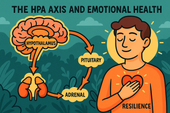
The HPA Axis and Emotional Health: The Hidden Bridge Between Stress and Mind
Neuroplasticity — the brain’s ability to rewire and adapt — is the foundation of emotional healing and resilience. When you face stress, trauma, or change, your neural pathways can reshape themselves to support new patterns of calm, focus, and self-awareness. Learn how daily practices like mindfulness, therapy, and breathwork strengthen neuroplasticity to transform emotional pain into personal growth. 🌸
-

Why Cortisol Control Is Key to Resilience: Mastering Stress to Build Emotional Strength
Controlling cortisol — the body’s main stress hormone — is the secret to lasting resilience. When cortisol levels stay balanced, your mind becomes clearer, emotions steadier, and energy more sustainable. Learn how breathwork, mindset shifts, adaptogens, and daily rhythms can help you calm your stress response and build true inner strength. 🌞💪
-
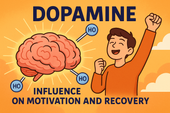
Dopamine’s Influence on Motivation and Recovery: Reigniting Drive and Balance
Healthy relationships are the foundation of emotional balance and resilience. Whether romantic, familial, or platonic, genuine connection releases dopamine, serotonin, and oxytocin — the brain’s “bonding trio” — helping us feel secure, motivated, and seen. Learn how trust, empathy, and communication not only strengthen your connections but also reshape your nervous system for deeper emotional well-being. 🌿🤝
-
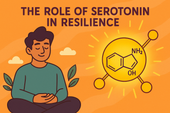
The Role of Serotonin in Resilience: How This “Mood Molecule” Shapes Emotional Strength
Serotonin — often called the “resilience molecule” — plays a vital role in how we handle stress, regulate mood, and recover from emotional challenges. Beyond happiness, this powerful neurotransmitter helps balance the gut-brain axis, stabilize the nervous system, and support emotional flexibility. Learn how nutrition, sunlight, mindfulness, and adaptogens can naturally boost serotonin and strengthen your emotional resilience. 🌞🧠
-

How Neuroplasticity Supports Emotional Growth: Rewiring the Brain for Resilience
Neuroplasticity is the brain’s built-in power to grow, adapt, and heal — and it’s the foundation of emotional transformation. Every mindful breath, compassionate act, or reframed thought strengthens new neural pathways that support resilience and self-awareness. Learn how your brain rewires through daily habits, helping you turn emotional challenges into opportunities for growth and calm. 🌿
-

Tai Chi and Adaptogens for Mind-Body Balance: The Art of Harmonizing Energy and Resilience
Alchemy isn’t just an ancient science — it’s a timeless symbol of transformation and inner balance. By blending the physical and spiritual, alchemy teaches us that change begins from within. Just as metals are refined into gold, we too can transmute emotional pain, stress, and chaos into clarity and strength through mindful practice and self-awareness. 🌙✨
-

Cold Therapy and Emotional Control: Training the Mind Through the Body
Cold therapy isn’t just for athletes — it’s a tool for emotional mastery. By exposing your body to controlled cold, you train your nervous system to stay calm under stress, improving focus, mood, and resilience. This article explores the science of cold exposure, its impact on hormones and the vagus nerve, and how ice baths and cold showers can help you build emotional control, one breath at a time. 🧊🧘♂️
-

How Music Influences Emotional Recovery: The Healing Soundtrack of the Mind
Neuroplasticity — the brain’s ability to rewire and heal itself — is at the heart of emotional recovery. Through mindful habits, music, therapy, and consistent mental stimulation, your brain can form new connections that support resilience and well-being. Discover how neuroplasticity turns pain into growth, helping you rebuild balance, focus, and emotional strength. 🌿
-
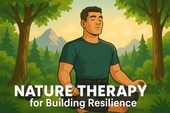
Nature Therapy for Building Resilience: Reconnecting With the Healing Power of the Earth
Nature therapy helps rebuild emotional resilience by reconnecting you with the healing rhythms of the Earth. From forest walks to sunlight exposure, nature restores balance to your nervous system, lowers stress hormones, and teaches emotional adaptability. Learn how spending time outdoors can enhance mental clarity, calm anxiety, and awaken your natural capacity to heal. 🌞
-

Breathwork Techniques That Pair with Supplements: The Ultimate Synergy for Stress Relief and Mental Clarity
Breathwork and supplements create a powerful mind-body synergy for stress relief, focus, and energy. By combining intentional breathing with adaptogens, nootropics, and calming nutrients, you can naturally regulate cortisol, sharpen mental clarity, and boost emotional balance. This guide explores the best breathwork techniques and supplement pairings to help you feel centered, calm, and energized from the inside out. 🌿
-
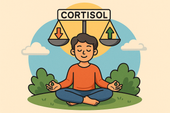
Why Cortisol Balance Matters for Emotional Strength
Balancing cortisol — your body’s main stress hormone — is essential for emotional resilience. When cortisol is chronically high, your mind stays stuck in survival mode, leading to fatigue, anxiety, and emotional instability. This article explores how nutrition, supplements, breathwork, and therapy can help restore healthy cortisol rhythms, regulate the nervous system, and strengthen your ability to handle life’s challenges with calm focus and emotional strength. 🌿
-

Best Supplements for Students During Exam Season: Focus, Energy, and Memory Support
Studying late into the night? Learn which natural supplements can boost focus, memory, and mental stamina during exam season — without the crash. From omega-3s to Bacopa and Rhodiola, discover your brain’s ultimate exam support stack. 🎓🧠
-

Natural Memory Boosters for Seniors: How to Keep Your Mind Sharp and Focused
Stay mentally sharp and confident as you age. Discover science-backed natural supplements and lifestyle habits that boost memory, focus, and brain longevity for seniors. 🌿🧠
-
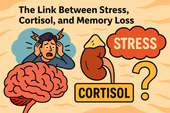
The Link Between Stress, Cortisol, and Memory Loss
Chronic stress can quietly erode your memory — and cortisol is the key culprit. Learn how stress hormones affect the brain, why the hippocampus shrinks under pressure, and how natural strategies can help you restore memory and mental clarity. 🧠✨
-

How to Build a Daily Supplement Routine for Memory Health
Want to sharpen your memory and stay mentally clear? Learn how to build a daily supplement routine for memory health — from morning focus to nighttime brain repair. Discover science-backed nutrients that boost recall, focus, and long-term cognitive resilience. 🧠🌿
-
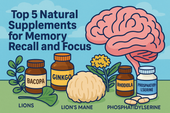
Top 5 Natural Supplements for Memory Recall and Focus
Looking to boost memory and concentration naturally? Discover the top 5 supplements — Bacopa, Ginkgo Biloba, Lion’s Mane, Rhodiola, and Phosphatidylserine — that enhance focus, recall, and long-term brain health. 🧠✨
-

Top Supplements to Balance Mood Naturally
From omega-3s to adaptogens, discover the top natural supplements proven to support emotional balance, reduce stress, and promote inner calm — safely and effectively. 🌿✨
-

Can Omega-3 Fatty Acids Help with Mood Disorders?
Omega-3 fatty acids do more than support heart health — they can help balance mood, reduce depression, and calm anxiety. Discover how EPA and DHA nourish your brain, fight inflammation, and support emotional well-being from within. 🌊🧠
-

Vitamin D and Mood: The Sunshine Vitamin for Emotional Balance
Could the key to emotional balance be as simple as a little sunlight? Discover how vitamin D — the sunshine vitamin — influences serotonin, reduces inflammation, and helps you feel more positive and resilient year-round. ☀️💛
-

The Role of Magnesium in Reducing Irritability and Low Mood
Feeling on edge or emotionally drained? Magnesium could be the missing link between your body and your mood. Discover how this essential mineral reduces irritability, balances neurotransmitters, and helps your nervous system find calm again. 🌿✨
-

How Probiotics Influence Mood Through the Gut-Brain Axis
Discover how probiotics can do more than support your digestion—they can actually uplift your mood. This article explores the fascinating gut-brain axis and how balancing your gut bacteria through probiotics may help reduce anxiety, improve emotional stability, and support long-term mental well-being. 🌿🧠
-
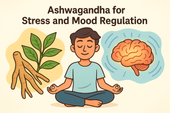
Ashwagandha for Stress and Mood Regulation
Discover how Ashwagandha, the powerful adaptogenic herb 🌿, helps your body manage stress and regulate mood. Learn how it balances cortisol, boosts GABA and serotonin, and supports emotional stability — helping you feel calm, focused, and resilient every day.
-
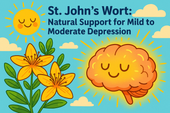
St. John’s Wort: Natural Support for Mild to Moderate Depression
Discover how St. John’s Wort, the “sunshine herb” 🌼, naturally supports mild to moderate depression. Learn how it boosts serotonin, balances mood, and promotes emotional resilience — with research showing its effectiveness compares to antidepressants, but with fewer side effects.
-
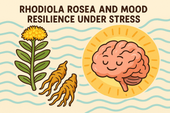
Rhodiola Rosea and Mood Resilience Under Stress
Discover how Rhodiola rosea helps your body adapt to stress 🌿. Learn how this powerful adaptogen balances cortisol, supports serotonin and dopamine, and strengthens emotional resilience — helping you stay calm, focused, and energized under pressure.
-

Chamomile and Lavender: Herbal Calm for Emotional Fluctuations
Discover how chamomile and lavender bring calm to emotional ups and downs 🌿. Learn how these two soothing herbs balance your nervous system, ease anxiety, and support restful sleep — naturally helping you find peace and emotional stability.
-

Saffron Extract and Its Surprising Benefits for Mood Disorders
Discover how saffron extract — the golden spice of joy 🌸 — can naturally support mood balance, ease anxiety, and lift mild depression. Learn what science says about its serotonin-boosting power, the ideal dosage, and how this ancient remedy compares to modern antidepressants.
-
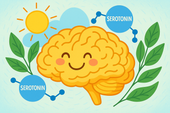
5-HTP and Serotonin: A Natural Path to Lifting Mood
Discover how 5-HTP naturally boosts serotonin 🌞 — the neurotransmitter behind mood, sleep, and emotional balance. Learn how this plant-derived compound supports happiness, reduces anxiety, and improves rest by helping your brain create more serotonin the gentle, natural way.
-

GABA Supplements for Reducing Anxiety and Mood Swings
Discover how GABA supplements can help reduce anxiety and balance mood naturally 🌿. Learn how this calming neurotransmitter works to quiet the mind, ease stress, and improve sleep — plus which nutrients and habits can boost your body’s own GABA production for long-term emotional stability.
-
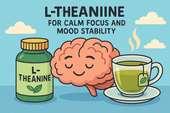
L-Theanine for Calm Focus and Mood Stability
Discover how L-theanine, the calming compound found in green tea 🍵, promotes focus, relaxation, and mood stability. Learn the science behind how it balances neurotransmitters, reduces stress hormones, and enhances clarity — helping you stay centered, calm, and productive without sedation.
-

B Vitamins and Brain Chemistry: Supporting Energy and Emotional Balance
Discover how B vitamins power your brain chemistry ⚡. Learn how B6, B9, and B12 support serotonin, dopamine, and energy production — helping boost focus, mood, and emotional balance. From diet to supplements, explore how this vital nutrient group keeps your mind resilient and your energy steady.
-

N-Acetyl Cysteine (NAC) and Mood Disorders: What the Research Says
Learn how N-Acetyl Cysteine (NAC) supports brain health and mood balance 🧠. Discover how this antioxidant helps reduce oxidative stress, regulate glutamate, and improve emotional stability in depression, bipolar disorder, and anxiety — backed by cutting-edge psychiatric research.
-

Supplements for Bipolar Disorder: What May Support Stability
Discover the best supplements for bipolar disorder 🌿 that may support emotional stability and brain health. Learn how nutrients like omega-3s, magnesium, vitamin D, and NAC can help reduce inflammation, balance neurotransmitters, and complement traditional treatment safely.

















































